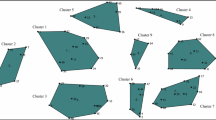Abstract
The Engaging Men project aimed to identify facilitators, societal approaches to and support for domestic violence, and barriers to men’s participation in domestic violence research, assessing the importance of each factor. Participatory concept mapping was used with a convenience sample of men (n = 142) in person and online across Australia, Canada and the United States of America. Engaging Men identified 43 facilitators, societal approaches to and support for domestic violence, and/or barriers to men’s participation in domestic violence research. The strongest facilitators related to external connections, such as concern for women around them. Men also recognized societal approaches to and support for domestic violence and the strongest barriers centered on internal feelings, including fear, shame and guilt about being linked to domestic violence. This study suggests that providing a safe environment for men to express genuine thoughts, feeling and views about domestic violence is vital, yet rarely available in domestic violence research. Therefore, research opportunities need to be more effectively designed and incentivized to address challenging issues identified by men, such as fear, shame and guilt and offer meaningful opportunities to demonstrate positive change.


Similar content being viewed by others
Notes
Community Animator is someone from the local community(ies) who knows how and where to engage individuals as change agents in the community.
References
Australian Bureau of Statistics. (2013). Personal safety. Retrieved from Canberra, Australia:
Australian Domestic and Family Violence Clearinghouse. (2011). The Impact of Domestic Violence on Children: A Literature Review.
Black, M. C., Basile, K. C., Breiding, M. J., Smith, S. G., Walters, M. L., Merrick, M. T., et al. (2011). The national intimate partner and sexual violence survey (NISVS): 2010 summary report. Atlanta, GA: National Center for Injury Prevention and Control, Centers for Disease Control and Prevention, 25.
Burke, J. G., O’Campo, P., Peak, G. L., Gielen, A. C., McDonnell, K. A., & Trochim, W. M. K. (2005). An introduction to concept mapping as a participatory public Health Research method. Qualitative Health Research, 15(10), 1392–1410. https://doi.org/10.1177/1049732305278876.
Casey, E. A., Leek, C., Tolman, R. M., Allen, C. T., & Carlson, J. M. (2017). Getting men in the room: Perceptions of effective strategies to initiate men’s involvement in gender-based violence prevention in a global sample. Culture, Health & Sexuality, 19(9), 979–995.
Cox, P. (2015). Violence Against Women in Australia: Additional Analysis of the Australian Bureau of Statistics' Personal Safety Survey, 2012: ANROWS.
Daoud, N., Urquia, M. L., O'Campo, P., Heaman, M., Janssen, P. A., Smylie, J., & Thiessen, K. (2012). Prevalence of abuse and violence before, during, and after pregnancy in a National Sample of Canadian women. American Journal of Public Health, 102(10), 1893–1901. https://doi.org/10.2105/ajph.2012.300843.
Ellsberg, M., Jansen, H., Heise, L., Watts, C. H., & Garcia-Moreno, C. (2008). WHO multi-country study on Women's health and domestic violence against women study team. Intimate partner violence and women's physical and mental health in the WHO multi-country study on women's health and domestic violence: An observational study. Lancet, 371(9619), 1165–1172.
Fetterman, D. M. (2001). Foundations of empowerment evaluation: Sage.
Flood, M. (2010). Where men stand: Men's roles in ending violence against women.
Flood, M. (2015). Work with men to end violence against women: a critical stocktake. Culture, Health & Sexuality, 17(sup2), 159–176.
Funk, R. E. (2006). Reaching men: Strategies for preventing sexist attitudes, behaviors, and violence: Jist life.
Grove, J. (2012). Engaging men against violence. In G. Kirk & M. Okazawa-Rey (Eds.), Women's Lives: Multicultural Perspectives (6 ed.): McGraw-Hill.
Jewkes, R., Flood, M., & Lang, J. (2015). From work with men and boys to changes of social norms and reduction of inequities in gender relations: A conceptual shift in prevention of violence against women and girls. The Lancet, 385(9977), 1580–1589.
Kane, M., & Trochim, W. M. (2007). Concept mapping for planning and evaluation (Vol. 50): Sage.
Kimball, E., Edleson, J. L., Tolman, R. M., Neugut, T. B., & Carlson, J. (2013). Global efforts to engage men in preventing violence against women: An international survey. Violence Against Women, 19(7), 924–939.
Minerson, T. (2011). Issue brief: Engaging men and boys to reduce and prevent gender-based violence.
O'Campo, P., Smylie, J., Minh, A., Omand, M., & Cyriac, A. (2015). Conceptualizing acts and behaviours that comprise intimate partner violence: A concept map. Health Expectations, 18(6), 1968–1981.
Patton, M. (2002). Qualitative research and evaluation methods: integrating theory and practice (Fourth Edition ed.). London: Sage Publications.
Southern, D., Batterham, R., Appleby, N., Young, D., Dunt, D., & Guibert, R. (1999). The concept mapping method. An alternative to focus group inquiry in general practice. Australian family physician, 28, S35–S40.
Statistics Canada. (2011). Family violence in Canada: A statistical profile. Retrieved from Ottawa, ON:
Trochim, W. M. (1985). Pattern matching, validity, and conceptualization in program evaluation. Evaluation Review, 9(5), 575–604.
Trochim, W. M. K. (1989). An introduction to concept mapping for planning and evaluation. Evaluation and Program Planning, 12(1), 1–16. https://doi.org/10.1016/0149-7189(89)90016-5.
United Nations. (1993). United Nations declaration on the elimination of violence against women. In.
Velonis, A. J. (2013). Are all hits the same? A mixed methods investigation of gender and violence in heterosexual relationships.
Author information
Authors and Affiliations
Corresponding author
Rights and permissions
About this article
Cite this article
Maddox, R., O’Campo, P., Grove, J. et al. Identifying how to Engage Men in Domestic Violence Research: a Concept Mapping Study. J Fam Viol 34, 781–793 (2019). https://doi.org/10.1007/s10896-018-9985-0
Published:
Issue Date:
DOI: https://doi.org/10.1007/s10896-018-9985-0




